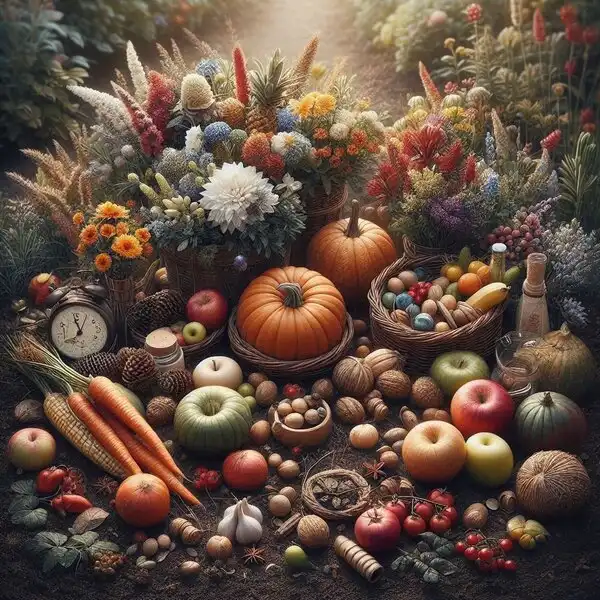Winter Gardening: Embracing Cold-Weather Growing
Winter gardening presents a unique opportunity for enthusiasts to continue their gardening endeavors even in the coldest months. Embracing cold-weather growing comes with several benefits, from ensuring a fresh supply of vegetables to maintaining a connection with nature throughout the year.

Benefits of Winter Gardening
Winter gardening offers numerous advantages, both practical and therapeutic. Firstly, it allows individuals to enjoy fresh produce during the winter months, reducing reliance on store-bought vegetables. Additionally, tending to a winter garden provides an opportunity for outdoor activity and exercise, promoting physical and mental well-being.
Furthermore, winter gardening fosters a sense of self-sufficiency and resilience by enabling individuals to grow their food year-round. It also allows gardeners to experiment with cold-hardy crops and innovative growing techniques, expanding their gardening knowledge and skills.
Indoor Gardening Techniques for Winter Harvests
Indoor gardening techniques play a crucial role in sustaining winter harvests. By utilizing indoor spaces effectively, gardeners can extend the growing season and ensure a continuous supply of fresh greens throughout the colder months.
One popular indoor gardening technique is growing lettuce and greens indoors. With proper lighting and environmental control, individuals can cultivate a variety of leafy greens, including lettuce, spinach, and kale, within the comfort of their homes.
Extending the Growing Season: Strategies for Success
Extending the growing season requires careful planning and implementation of various strategies. Cold frames, hoop houses, and row covers are effective tools for protecting plants from frost and harsh weather conditions, allowing them to thrive well into the winter months.
Moreover, starting seeds early indoors and utilizing seed starting setups enable gardeners to get a head start on their winter gardens. By transplanting seedlings outdoors at the optimal time, individuals can maximize their growing season and enjoy a bountiful harvest even in challenging climates.
Indoor Gardening: Harvesting Greens All Year Round
Indoor gardening opens up a world of possibilities, allowing you to enjoy fresh greens regardless of the season. With the right techniques and tools, you can cultivate a thriving indoor garden and harvest greens all year round.
Growing Lettuce and Greens Indoors
Lettuce and other leafy greens are well-suited for indoor cultivation, making them ideal candidates for year-round harvesting. To grow lettuce indoors, select a suitable container with adequate drainage and fill it with nutrient-rich potting soil. Sow lettuce seeds evenly and cover them lightly with soil, ensuring proper spacing between plants to allow for adequate airflow.
Place the container in a location that receives plenty of natural light or supplement with grow lights to provide sufficient illumination. Keep the soil consistently moist but not waterlogged, and fertilize regularly with a balanced fertilizer to promote healthy growth. With proper care, you can enjoy a continuous harvest of fresh lettuce and greens from your indoor garden.
Cultivating Microgreens Under Grow Lights
Microgreens are young, tender greens harvested at an early stage of growth, making them a nutritious and flavorful addition to salads, sandwiches, and smoothies. Cultivating microgreens indoors is relatively simple and requires minimal space, making them perfect for urban dwellers and those with limited gardening space.
To grow microgreens, fill a shallow tray or container with a thin layer of potting soil and scatter the seeds evenly across the surface. Mist the seeds lightly with water and cover the container with a lid or plastic wrap to retain moisture. Place the container under grow lights or in a sunny window, ensuring the seeds receive adequate light to germinate and grow.
Utilizing Seed Starting for Early Transplants
Seed starting is a valuable technique for getting a head start on your indoor garden and ensuring early transplants for the outdoor growing season. By starting seeds indoors several weeks before the last frost date, you can nurture young seedlings and transplant them into the garden once the weather warms up.
To start seeds indoors, use seed trays or small pots filled with seed starting mix. Sow the seeds according to the instructions on the seed packet and place the trays or pots in a warm, brightly lit area. Keep the soil consistently moist and provide adequate airflow to prevent damping off disease. Once the seedlings have developed true leaves and are strong enough to transplant, carefully transplant them into larger containers or directly into the garden soil.
Our blog post on Explore homemade freeze dried corn is a must-read for anyone interested in the subject. It’s filled with comprehensive details and thoughtful perspectives.
Transitioning Seasons: From Summer to Fall Gardening
As the warm days of summer give way to the cooler temperatures of fall, it's time to transition your garden to accommodate the changing seasons. With proper planning and care, you can extend your growing season and continue to enjoy fresh produce well into the fall months.
Managing Garden Space Challenges
One of the biggest challenges when transitioning from summer to fall gardening is managing limited garden space. As summer crops reach the end of their lifecycle, you'll need to clear out space to make room for fall plantings. Start by removing any spent plants and weeds, then assess your garden layout to determine where you can plant fall vegetables.
Consider utilizing vertical gardening techniques such as trellises and garden towers to maximize space and grow more in less area. Raised beds and container gardening are also great options for small spaces, allowing you to create a productive garden even in limited areas.
Year-Round Seed Starting Setup
Having a year-round seed starting setup is essential for ensuring a continuous harvest and a smooth transition between seasons. Set up a dedicated area in your home or garden shed equipped with shelving units, grow lights, and seed starting trays.
Start seeds for fall vegetables indoors several weeks before the anticipated planting date, giving them time to germinate and develop into strong seedlings. Keep the seedlings under grow lights or in a sunny window to provide adequate light, and maintain consistent moisture levels to promote healthy growth.
Optimal Timing for Fall Planting
Timing is crucial when it comes to fall planting, as you'll need to sow seeds and transplant seedlings at the right time to ensure a successful harvest before the first frost. Consult a planting calendar or local gardening resources to determine the optimal planting dates for fall vegetables in your area.
Our in-depth coverage on Discover the details of freeze dry ice cream tips provides a wealth of information and insights. Be sure to check it out for a comprehensive understanding of the topic.
Generally, cool-season crops such as lettuce, spinach, kale, and broccoli should be planted in late summer or early fall to allow them to mature before the onset of winter weather. Be sure to provide adequate protection for tender plants as temperatures begin to drop, using row covers or cold frames to extend the growing season even further.
Find out everything you need to know about Explore delicious chicken bone broth in our detailed article. It's a valuable resource for anyone looking to learn more.
Dive into our article on Understand mobile chicken coop review for a complete overview. We cover all the essential points and provide a lot of useful information.
Conclusion: Embracing Year-Round Gardening
Congratulations on taking the first steps towards embracing year-round gardening! As you've learned throughout this guide, gardening doesn't have to end when the temperatures drop. By adopting cold-weather growing methods, you can continue to enjoy fresh produce and the many benefits of gardening even in the midst of winter.
Overcoming Mindset Barriers to Cold-Weather Gardening
One of the biggest challenges to year-round gardening is overcoming mindset barriers. Many people assume that gardening is strictly a warm-weather activity and may feel discouraged by the thought of gardening in cold weather. However, with the right knowledge and techniques, you can overcome these barriers and discover the joys of winter gardening.
Shift your mindset by embracing the unique opportunities that cold-weather gardening offers. Instead of viewing winter as a dormant period for your garden, see it as a time to experiment with new crops and growing methods. With proper planning and preparation, you can cultivate a thriving garden throughout the year.
Exploring Resources for Further Learning
If you're eager to dive deeper into the world of year-round gardening, there are plenty of resources available to help you expand your knowledge and skills. Consider joining online gardening communities or forums where you can connect with fellow gardeners, ask questions, and share your experiences.
Additionally, there are many books, blogs, and podcasts dedicated to cold-weather gardening that can provide valuable insights and inspiration. Take advantage of these resources to learn new techniques, discover new plant varieties, and stay informed about the latest trends in year-round gardening.
Take Action: Start Your Winter Garden Today!
Now that you have the knowledge and resources you need, it's time to take action and start your winter garden today! Begin by assessing your garden space and identifying areas where you can implement cold-weather growing methods such as raised beds, cold frames, or indoor gardening setups.
Choose a few cold-hardy vegetables to plant, such as kale, spinach, carrots, and Brussels sprouts, and start sowing seeds or transplanting seedlings according to the optimal planting dates for your region. Remember to monitor your garden closely, provide adequate protection from frost and extreme temperatures, and adjust your care routine as needed to ensure a successful harvest.
By taking action now, you'll not only enjoy a bountiful winter harvest but also gain valuable experience that will serve you well in future growing seasons. Embrace the challenges and rewards of year-round gardening, and discover the joy of growing your own food no matter the season!

 Emma
Emma

